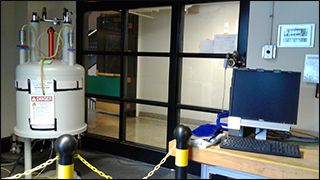Description

Quantum information processing experiment equipment.
This experiment will let you perform a series of simple quantum computations on a two spin system, demonstrating one and two quantum-bit quantum logic gates, and a circuit implementing the Deutsch-Jozsa quantum algorithm. You will use NMR techniques and manipulate the state of a proton and a carbon nucleus in a chloroform molecule, measuring ensemble nuclear magnetization.
WARNING: You should know MATLAB® well to successfully do this experiment! You will measure:
- the coupling constant describing the electron-mediated interaction between the proton and carbon nuclear spins of chloroform,
- the classical input-output truth table for a controlled-NOT gate
- the numerical output of the Deutsch-Jozsa quantum algorithm, and
- optionally, the output and oscillatory behavior of the Grover quantum search algorithm.
Lab Guide
Quantum Information Processing with NMR Lab Guide (PDF)
References
Landauer, R. “Irreversibility and Heat Generation in the Computing Process.” IBM Journal of Research and Development 183 (1961): 183-191.
Bennett, C. H. “Logical Reversibility of Computation.” IBM Journal of Research and Development 525 (1973): 525-532.
Benioff, P. “The Computer as a Physical System: A Microscopic Quantum Mechanical Hamiltonian Model of Computers as Represented by Turing Machines.” Journal of Statistical Physics 22 (1980): 563-591.
Feynman, R. P. “Simulating Physics with Computers.” International Journal of Theoretical Physics 21 (1982): 467-488.
Fredkin, E., and T. Toffoli. “Conservative Logic.” International Journal of Theoretical Physics 21 (1982): 219-253.
Feynman, R. P. “Quantum Mechanical Computers.” Optics News 11 (1985): 11-20.
Deutsch, David. “Quantum Theory, the Church-Turing Principle and the Universal Quantum Computer.” Proceedings of the Royal Society of London A400 (1985): 97-117.
———. “Quantum Computational Networks.” Proceedings of the Royal Society of London A425 (1989): 73-90.
Leff, H., and R. Rex. Maxwell’s Demon: Entropy, Information, Computing. Princeton, NJ: Princeton University Press, 1991. ISBN: 9780691087276.
Deutsch, David, and Richard Jozsa. “Rapid Solution of Problems by Quantum Computation.” Proceedings of the Royal Society of London A439 (1992): 553-558.
Shor, P. W. “Algorithms for Quantum Computation: Discrete Logarithms and Factoring.” Annual Symposium on Foundations of Computer Science 35 (1994): 124-134.
Simon, D. R. “On the Power of Quantum Computation”. Annual Symposium on Foundations of Computer Science 35 (1994): 116-123.
Grover, L. “A Fast Quantum Mechanical Algorithm for Database Search.” Proceedings of the 28th Annual ACM Symposium on Theory of Computing (1996): 212-219.
Gershenfeld, N., and I. Chuang. “Bulk Spin-Resonance Quantum Computation.” Science 275 (1997): 350-356.
Cory, D., A. Fahmy, and T. Havel. “Ensemble Quantum Computing by NMR Spectroscopy.” Proceedings of the National Academy of Sciences of the United States of America 94 (1997): 1634-1639.
Warren S. W., N. Gershenfeld, and I. Chuang. “The Usefulness of NMR Quantum Computing”. Science. 277, no. 5332 (1997): 1688-1690.
Chuang, Isaac L., Neil Gershenfeld, and M. Kubinec. “Experimental Implementation of Fast Quantum Searching.” The Physical Review Letters 80, no. 15 (April 13, 1998): 3408-3411.
Chuang, Isaac L., L. M. K. Vandersypen, X. L. Zhou, D. W. Leung, and S. Lloyd. “Experimental Realization of a Quantum Algorithm.” Nature 393, no. 6681 (1998): 143-146.
Gershenfeld, Neil, and Isaac Chuang. “Quantum Computing with Molecules (PDF).” Scientific American (June 1998): 66-73.
Sodickson, A., and D. G. Cory. “A Generalized k-space Formalism for Treating the Spatial Aspects of a Variety of NMR Experiments.” Progress in Nuclear Magnetic Resonance Spectroscopy 33 (1998): 77-108.
Price, M., S. Somaroo, C. Tseng, J. Gore, A. Fahmy, T. Havel, and D. Cory. “Construction and Implementation of NMR Quantum Logic Gates for Two Spin System (PDF).” Journal of Magnetic Resonance 140 (1999): 371-378.
Cory, D., R. LaFlamme, E. Knill, L. Viola, T. Havel, N. Boulant, G. Boutis, E. Fortunato, S. Lloyd, R. Martinez, C. Negrevergne, M. Pravia, Y. Sharf., G. Teklemariam, Y. Weinstein and W. Zurek. “NMR Based Quantum Information Processing: Achievements and Prospects.” Quantum Physics 48 (2000): 875-907.
Chuang, Isaac L., and Michael A. Nielsen. Quantum Computation and Quantum Information. New York, NY: Cambridge University Press, November 2000, chapter 1. ISBN: 9780521632355.
Vandersypen, L., C. Yannoni and I. Chuang. “Liquid State NMR Quantum Computing.” The Encyclopedia of NMR, Edited by D. Grant and R. Harris, John Wiley and Sons (2001).
Havel, T. F., D. G. Cory, S. Lloyd, N. Boulant, E. M. Fortunato, M. A. Pravia, G. Teklemariam, Y. S. Weinstein, A. Bhattacharyya, and J. Hou. “Quantum Information Processing by Nuclear Magnetic Resonance Spectroscopy.” American Journal of Physics 70 (March 2002): 345-362.
Chuang, I.L. “How Proton and Carbon Spectra Arise from Density Matrix (PDF)”, April 2003.
Gulde, S., M. Riebe, G. Lancaster, C. Becher, J. Eschner, H. Haffner, F. Schmidt-Kaler, I. Chuang and R. Blatt. “Implementation of the Deutsch-Jozsa Algorithm on an Ion-trop Quantum Computer.” Nature 421 (January 2, 2003): 48-50.
Sakurai, J. “Ensemble Averages and Density Operator.” In Modern Quantum Mechanics. 2nd ed. Reading, MA: Addison-Wesley, 1993, pp. 176-180. ISBN: 9780201539295.










